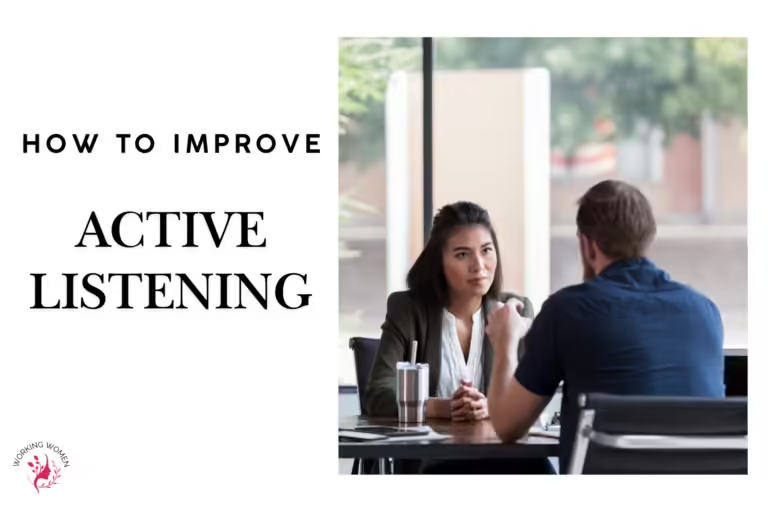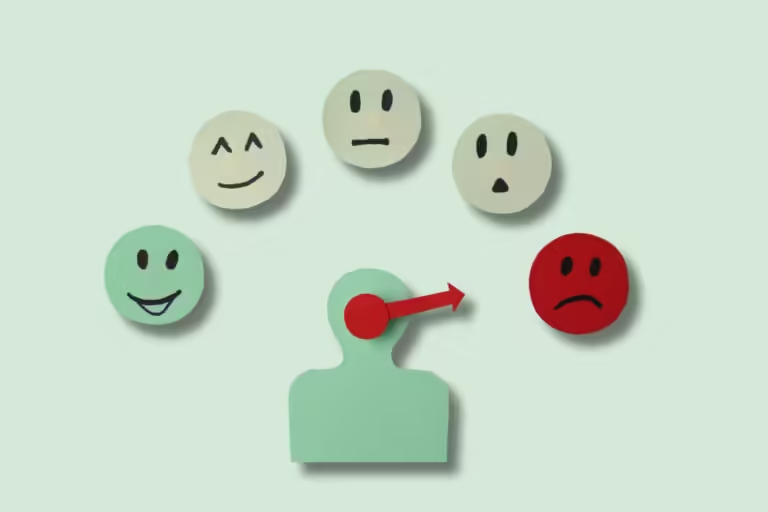Power of Non verbal communication: Lead, Collaborate & Negotiate Effectively
Non verbal communication is a powerful force that shapes your interactions. Have you ever walked away from a conversation feeling misunderstood, even if you said all the “right” words? The truth is, what you say matters less than how you say it.
Your body language, tone of voice, and expressions reveal your true feelings and shape how others perceive you. In this article, discover how to harness this silent language to boost your self-awareness, accurately read the people around you, and even navigate those tricky workplace conversations with greater ease.
What is Non Verbal Communication?
Non verbal communication refers to all the ways we communicate without using words. It’s a complex system involving body language like posture and gestures, facial expressions, eye contact, tone of voice, touch, and even how we use space.
Nonverbal cues often subconsciously reveal our true emotions, intentions, and attitudes. They play a crucial role in how we understand others and how we present ourselves in the workplace.
What is 55/38/7 Formula in non verbal communication?
Albert Mehrabian is a Professor Emeritus of Psychology at the University of California, Los Angeles famous for his studies on the relative impact of verbal and nonverbal messages, particularly in situations where there are inconsistencies between the two.
Mehrabian’s research suggested that when communicating feelings and attitudes, the breakdown of importance is:
- 7% Verbal (the actual words spoken)
- 38% Vocal (tone of voice, pitch, pace)
- 55% Body Language
The relative importance of verbal and nonverbal communication can shift depending on the situation and what’s being conveyed. For example, words would matter more when giving precise technical instructions.
Types of NonVerbal Communication
According to the research, there are 6 types of Nonverbal communication.
- Kinesics (Facial Expression, Eye Contact, Gesture, Body Language & Posture)
- Paralanguage (Vocal cues (tone, volume, pitch, etc.)
- Haptics (Touch)
- Appearance (Clothing, Grooming, etc.)
- Proxemics (Personal Space)
- Olfactics (Perfume/body odor)
Facial Expression
Facial expressions are a powerful form of non verbal communication. Our faces are capable of conveying a vast range of emotions, often revealing our true feelings even when we try to conceal them. From smiles and frowns to subtle eyebrow movements, facial expressions play a crucial role in how we understand others and how others perceive us.
Some key emotions like happiness, sadness, and anger are recognized universally, highlighting the importance of facial expressions in interactions across cultures.
improve your Facial Expressions to enhance communication
Improving your facial expressions can enhance your workplace communication.
- Start by increasing your self-awareness through mirror work and video recordings.
- Learn to recognize the core emotional expressions and practice replicating them.
- You can even try gentle facial exercises to increase flexibility. Most importantly, focus on connecting with the emotion you want to convey, as this leads to more authentic expressions.
Remember, context is key! Adapt your facial expressions to match the situation and tone of the conversation.
Eye Contact
Eye contact is a significant aspect of non verbal communication, revealing levels of interest, confidence, respect, and even dishonesty. Direct eye contact often signals engagement and sincerity, while avoiding eye contact can suggest disinterest, discomfort, or lack of confidence.
How long we hold eye contact is also important, as both too little and excessive eye contact can be off-putting. Cultural differences exist, but in many Western cultures, good eye contact is a critical part of effective communication.
How to Improve Eye contact?
Start by increasing awareness of your own eye contact habits. Do you tend to look away quickly?
- Practice maintaining eye contact slightly longer than feels comfortable, gradually pushing your limits.
- Try focusing on one eye at a time if direct gaze feels too intense.
- If making eye contact in conversation triggers anxiety, start small by practicing during low-stakes interactions.
- To avoid looking too much in eyes of others, remember 80/20 Formula, in which we are looking 80% in other people’s eye and look away 20% to assemble our own thoughts.
Remember, appropriate eye contact varies by situation; consider the person and the context. Building strong eye contact takes effort, but it can boost your perceived confidence, persuasiveness, and trustworthiness significantly.
Body Language
Body language encompasses how we hold and move our bodies, including posture, gestures, and overall physical presence. Crossed arms might signal defensiveness, while an open stance and relaxed gestures suggest receptiveness. Body language speaks volumes, often revealing our subconscious attitudes and emotions. It plays a significant role in how others perceive us in various settings, including the workplace.
How to Improve Body Language for effective communication
Start by becoming more aware of your natural posture and movements. Do you tend to slouch or fidget?
- Practice standing or sitting tall with an open posture to project confidence.
- Use gestures intentionally, avoiding overly large or distracting movements.
- Be mindful of mirroring, as subtly mirroring the posture of the person you’re speaking with can build rapport.
Small changes in your body language can significantly impact how you are perceived, leading to more positive interactions and increased professional presence.
Posture
Posture, the way we hold our bodies while standing, sitting, or walking, is a crucial element of non verbal communication. Good posture, characterized by a straight spine, relaxed shoulders, and a lifted chin, conveys confidence, competence, and engagement.
On the other hand, slouching or slumped shoulders can signal disinterest, insecurity, or even physical discomfort. Our posture sends strong unconscious signals to others, shaping their perception of us.
How can you improve your Posture at work?
Improving your posture takes conscious effort.
- Start by practicing good standing posture: feet shoulder-width apart, knees slightly bent, and shoulders pulled back.
- When seated, maintain a straight back, avoid crossing your legs, and ensure your feet rest flat on the floor.
- Be mindful of your posture throughout the day, using reminders or posture-correcting tools if helpful.
Good posture not only boosts your professional image but can also reduce stress levels and physical discomfort during long work hours.
Gesture
Gestures are deliberate movements of the hands, arms, or head used to communicate or emphasize a message. They can range from subtle hand motions to expansive arm movements. Gestures add nuance to our verbal communication, illustrating our ideas, expressing emotions, and even signaling intentions. They play a crucial role in how others perceive us and our messages.
Enhance Your Professional Presence by improving Gesture
Self-Awareness: Record yourself speaking or presenting. Analyze your current gesturing habits. Do you have distracting motions or appear too stiff?
- Learn the Basics:
- Open Gestures: Palms up, arms relaxed, and away from the body suggest openness and receptivity.
- Emphatic Gestures: Used sparingly to signal important points (e.g., a downward chop of the hand)
- Descriptive Gestures: Help illustrate a concept or size (e.g., using hands to indicate distance)
- Practice:
- Mirror-work: Practice in front of a mirror, incorporating intentional gestures into your speech.
- Rehearse presentations: Focus on integrating helpful gestures for emphasis and explanation.
- Ask for Feedback: Have a trusted friend or colleague observe and provide constructive criticism.
By using gestures mindfully, you can enhance your communication and create a more engaging and dynamic presence at work.
Vocal Cues (Paralanguage)
Vocal cues, also known as paralanguage, refer to all aspects of our voice beyond the actual words we speak. This includes tone, pitch, volume, pace, inflection, and pauses. The way we use our voice significantly impacts how our message is interpreted.
For example, a sarcastic tone can completely change the meaning of a statement, while a warm, reassuring tone can put someone at ease.
Tips for Powerful Vocal Cues
- Self-Awareness:
- Record Yourself: To become aware of your natural vocal patterns. Listen back to identify filler words (like, um), a weak or shaky voice, or a monotone delivery.
- Get Feedback: Ask a trusted colleague to give honest feedback on your vocal delivery.
- Practice and Technique:
- Breathing exercises: Deep breathing helps calm nerves and supports a strong voice. If anxiety impacts your voice, practice breathing exercises to calm down before important interactions.
- Articulation Drills: Practice modulating your pitch and varying your volume to emphasize key points and avoid sounding monotone.
- Vary Your Delivery: Experiment with pitch, volume, and pace for different effects.
- Mindset Matters:
- Confidence Visualization: Before important presentations, imagine yourself speaking with a clear, strong voice.
- Manage Anxiety: If nerves affect your voice, practice relaxation techniques or consider short-term use of a safe medication like beta-blockers.
Strong vocal cues can enhance your credibility, persuasiveness, and overall communication effectiveness at work. It is one of the most important aspect of non verbal communication.
Related: How Active Listening can impact your Professional Life
Haptics (Touch)
Haptics is the study of touch as a form of communication. It encompasses various types of physical contact, from a firm handshake or a brief pat on the shoulder, to more intimate touches like a hug. Touch can convey a wide range of messages, such as support, affection, dominance, or even aggression. It plays a significant role in building relationships and influencing how others perceive us.
Touch someone is a powerful form of non verbal communication. You show your engagement level and your emotions without saying a word. If you feel empathy or aggression, your touch will show it immediately.
How Can We Utilize Haptics Appropriately at Work?
Understanding the power of touch in the workplace is crucial. Generally, touch should be used sparingly and with respect for professional boundaries.
- Handshakes: A common and acceptable greeting in many professional settings. Keep it firm and brief.
- Celebratory Touch: A congratulatory pat on the back or shoulder might be acceptable after an accomplishment or good news. Keep it light and brief.
- Reassuring Touch: In highly collaborative environments offering a brief touch on the forearm during a difficult situation may be appropriate if you have a close working relationship. Use extreme caution with this.
Be mindful of cultural norms and individual preferences, and use touch judiciously at work to create a positive and respectful environment.
Appearance
Our appearance, encompassing clothing, hairstyle, grooming, and overall presentation, forms a powerful non verbal communication message. Before we even speak, others make judgments about our competence, professionalism, and trustworthiness based on how we look. First impression always matters in non verbal communication.
While personal style plays a role, our appearance sends a strong message about how we value ourselves and our work environment. It also boost your confidence.
How Can We Improve Our Appearance at Work?
- Dress Code and Company Culture:
- Understand Expectations: Know your company’s guidelines (formal, business casual, etc.).
- Observe Colleagues: Take cues from how others at your level and position dress.
- Clothing:
- Fit Matters: Clothes should fit well, neither too tight nor baggy.
- Clean and Wrinkle-Free: Ironed and laundered clothing is essential.
- Choose Quality Over Quantity: A few well-made outfits are better than a full closet of cheap items.
- Grooming:
- Hair: Neatly styled hair, appropriate for your workplace.
- Facial Hair: Well-trimmed if applicable.
- Nails: Clean and manicured.
- Makeup (if applicable): Subtle and professional.
- Accessories:
-
- Less is More: Keep jewelry and other accessories on the minimal side.
- Avoid Flashy or Distracting: The focus should be on you, not a giant watch or loud fragrance. Avoid overly flashy or distracting items
Investing in your appearance demonstrates a commitment to your work and conveys respect for your colleagues and clients. Make sure you project a professional image of yourself.
Personal Space (Proxemics)
Personal space, or proxemics, refers to the physical distance we maintain from others. It’s a culturally influenced concept with varying levels of comfort surrounding closeness. In many Western societies, respecting appropriate personal space conveys respect, whereas standing too close can feel intrusive or aggressive. Our use of space reveals our comfort level and signals the nature of the relationship (intimate, social, professional, etc.)
Personal space also include your own space you take, it shows your confidence level. As a non verbal communication naturally the more nervous or shy you are feeling the less space you will take. like you squeeze your hands or arms etc. On the other hand if you feel confident and relax your body will take more space.
How Can We Improve Our Personal Space at Work?
- Start by becoming aware of the typical personal space expectations in your workplace and culture.
- Observe how close colleagues stand when conversing and aim to mirror these norms.
- Avoid invading someone’s personal space, especially when they seem to pull away or exhibit discomfort.
- Be mindful in settings like elevators or shared workspaces, giving others a reasonable amount of room.
Respecting personal space fosters a sense of comfort and professionalism, leading to better communication and working relationships.
Olfactics
Olfactics refers to the role of smell in non verbal communication. Our sense of smell is powerful, and both natural body odors and artificial scents (like perfumes and colognes) can influence how others perceive us. Pleasant scents are often associated with attractiveness or cleanliness, while strong or unpleasant odors can send a negative message. Olfactics can even subconsciously trigger memories or emotions, influencing interactions without our conscious awareness.
How Can We Improve Our Olfactics at Work?
Good personal hygiene is essential, ensuring you manage natural body odors.
- Be mindful of strong perfumes or colognes, as some people are very sensitive to scent.
- Choose mild, subtle scents, or consider going fragrance-free in the workplace.
- If your work involves close contact with others (healthcare, food service, etc.), being particularly mindful of olfactics is crucial for professionalism and respect towards those you serve.
Conclusion
Non verbal communication encompasses a vast network of cues and signals that profoundly shape how we interact and are perceived by others. From facial expressions and body language to our use of space and even our appearance, we are constantly sending messages that go far beyond the words we choose.
Understanding these non verbal communication channels are essential for effective communication at work. It allows us to read people more accurately, project confidence and competence, and build strong, positive relationships. By becoming more mindful of our own nonverbal signals and learning to decode the cues of others, we unlock a powerful toolkit for success in any professional setting.







